Gustav Beer: Parisian Elegance and the Tailored Splendor of Early 20th-Century Fashion
📌 Discover the timeless fashion of Gustav Beer, Parisian designer of exquisite gowns and tailored suits from the Edwardian era through the 1920s. With stunning illustrations and social context, this article explores Beer's impact on travel fashion, modern femininity, and design innovation. A must-read for teachers, students, genealogists, and fashion historians.
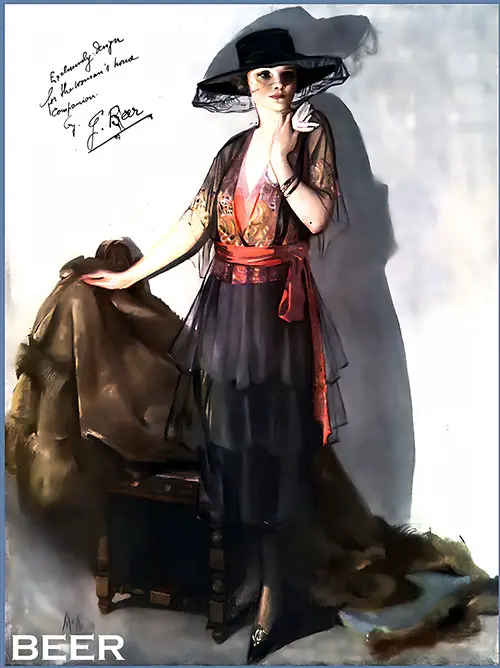
From Paris — This Afternoon Tea Frock Created by Beer for "Companion" Readers, Painted by Neysa McMein. Woman's Home Companion, September 1919, p. 27. | GGA Image ID # 1ca8f9629e
Gustav Beer – The Elegance of Expression in Early 20th-Century Fashion
A Deep Dive into Parisian Fashion and Transatlantic Style Culture for Educators, Students, Genealogists & Historians
⚓🧳👗
🎩 Introduction: Gustav Beer – The Tailor of Distinction
Gustav Beer, a prominent Parisian fashion designer active from the Edwardian era through the Roaring Twenties, was a couturier who balanced structure with softness, tailoring with femininity. His designs reflect not only Parisian flair but also the cosmopolitan culture of the steamship traveler, who sought refinement, ease, and impact whether at sea or in society salons.
Beer's collections, as documented in this visually rich article, are an ideal interdisciplinary resource that:
🎓 Supports fashion and design history courses
🧬 Informs genealogical context for family photos
🛳️ Illuminates the style of upper-class passengers aboard ocean liners
🖋️ Offers a rich primary source for students writing essays on gender, luxury, or modernity
Designer Beer selected a transparency soft, shimmery mousseline de soie to fashion this typically French frock. It's black, of course, for Paris always has a soft spot in her heart for black.
But he relieved the sober tone of the background by tucking in a gay little vest of coral mousseline. He then sashed the gown with silk in the same tone, tying it deftly at the side.
He made the waist brilliant with bands of coral, gold, and crystal beads, bloused it over the sash, and lengthened it under the sash into a long waistline.
Elbows are made to be seen, so the sleeves are only wisps of mousseline and delicate embroidery, adding a touch of femininity. The skirt concentrates its fullness at the sides, edges its ruffles with black silk buttonhole stitch, makes its middle ruffle fuller than the others -- and is just as short as it dares to be.
Beer's collection stands out as one of the season's most unique and intriguing successes. It exudes elegance without falling into the trap of eccentricity, ensuring it never for a moment becomes dull.
Beer's tailor-made collection is a delightful and exciting medley of styles, far from a single, stereotyped model. This diverse range is sure to spark the interest of fashion enthusiasts and professionals alike.
Beer's collection features a diverse range of jackets, with a slight inclination towards three-quarter coats and long lines. The collars are a mix of high necks and the unique shawl type, adding a touch of novelty. The skirts, though tight, incorporate a few gathers at the sides, cleverly shirred into pockets.
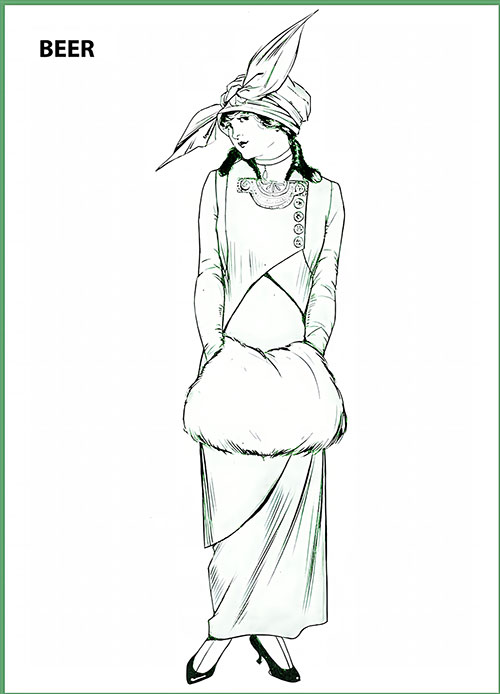
In a Green Duvetyn Suit, Beer Accentuates the Cutaway Form, Showing a Long Square-cut End in the Back Reaching the Knees. The Skirt Is High-waisted and Hangs Loosely From the Belt to the Knee in a Supple, Graceful Line. A Small Rolling Collar of Fur Runs Across the Back From Shoulder to Shoulder. Harper's Bazar, October 1913, p. 27. | GGA Image ID # 1ca934ac6e
A characteristic beige duvetyn suit with a rather long jacket has a vast shawl seal collar; the coat fits in at the waist through tiny lateral tucks all around. The skirt is box-pleated at the sides.
The leading stuff is duvetyn, velours de laine, mouflon, corduroys, and serge, in browns and many greens, blue-green, turquoise, and bottle.
Several plaids and velvet combined with satin complete the list. Long-coated models are either pinched at the waist and a little skirty or perfectly straight from neck to hem, as in the case of blue serge, the high collar, and substantial patch pockets made of narrow red and brown leather strips.
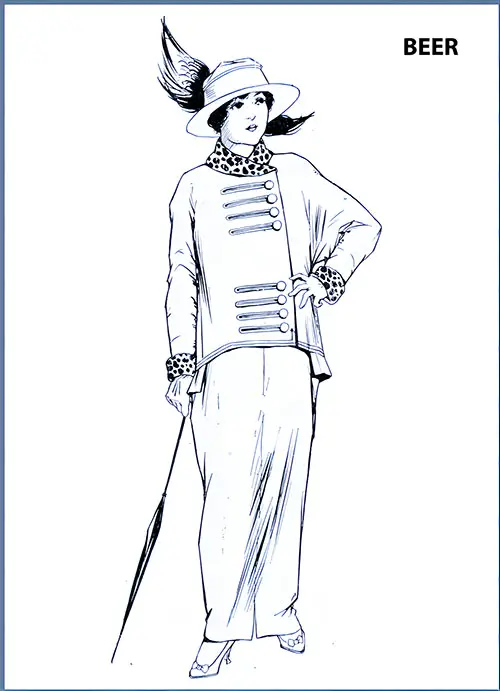
Beer Has Struck the Military Note in His Suit of Blue Cheviot, Braided With Black, and Cut With a Long-waisted Straight Bloused Coat, Belted Below the Hips. Perfectly Plain in Front, It Has Buttons on One Side and a Collar and Leopard Cuffs. Harper's Bazar, October 1913, p. 28. | GGA Image ID # 1ca969e811
A medium-coated, tailor-made coat, baptized "Succès," more than justified its name. Of fawn duvetyn, the trim, tight coat has an oversized round collar, vertical strips of mole giving it a fat, tire-like expanse; the sides of the jacket were likewise striped with the same fur opening into big pockets.
Embroidery is present; beautiful silkwork weighs down many a panel. One chic blue model, trimmed with squirrel, has a deep yoke, pointed at the back, of silver squares joined by stitching.
All the coats, be they for the evening, afternoon, or traveling, deserve the description because they are so different from everyone else's. We find much Agnella and velour among the big loose wraps.
The sleeves are particularly huge, a feature being to have them of fur on a wool coat. A beige blanket with immense Kolinsky sleeves is chic. Deep yokes and voluminous round collars of fur, rolled and standing out, contrast the stuff employed.
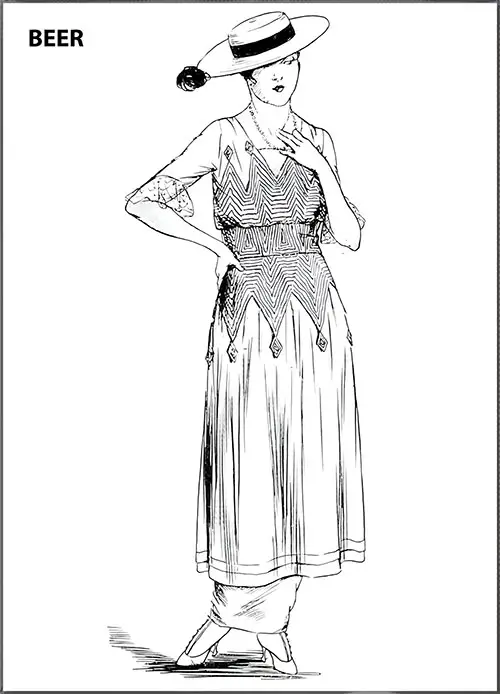
Beer Has Successfully Given the Slender Hip Effect in This Striking White Chiffon Utilizing an Elongated Girdle Made Entirely of White Silk Hercules Braid. The Corsage and the Long Tunic Are of White Chiffon, the Latter Banded With Green Crêpe de Chine. A Lace Frill Finishes the Tight-fitting Chiffon Sleeve. Harper's Bazar, August 1914, p. 52. | GGA Image ID # 1ca9909bf7
Another unusual collar is a large, straight piece of beaver folded over and ruched onto a big green wrap. Squirrel fur is treated in some mysterious way to look like chinchilla, a valuable secret now fur is so scarce.
The following wrap attracted significant attention: it is made of black velvet lined with purple satin. Three-quarters of it is shirred at the neck into a straight seal collar; the remainder, or loose flange, is flung over one shoulder like an Italian officer's cloak. The dress underneath, of purple satin with a red and purple sash, is buttoned down the front.
On evening coats, the yokes are immense. One example has a round one of brocade coming to the hips; a wide, long band of black velvet is draped over it in points, and a gathered band of beaver makes the collar. Other equally large yokes are a solid mass of beads and silk in brocade designs.
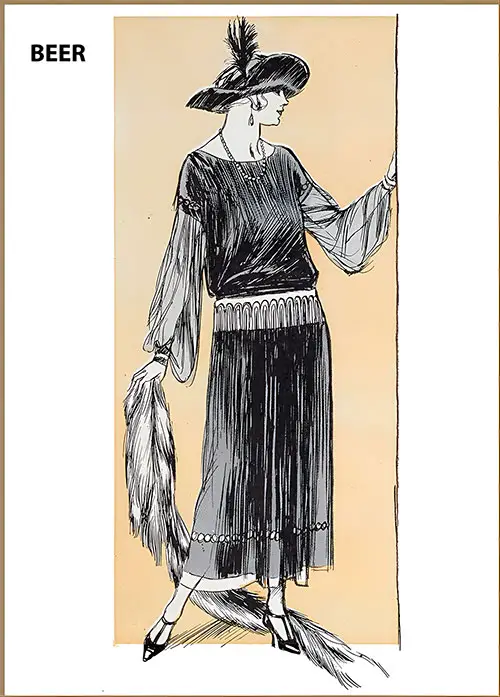
Beer Resorts to the Transparent Ruse of a Chiffon Hem To Lend the Effect of New Length to a Dress of Black Crepe de Chine, With Silver Embroidery on a Red Ribbon at the Waist. The Delineator, January 1922, p. 24. | GGA Image ID # 1cab165a04
This winter, the more embroidery, the better is the slogan—we hear it everywhere. This dead turquoise wrap is magnificent, much gathered and bunchy, striped in bands of cut steel down.
Of course, the straight line is popular for dresses. It is not too loose, for I do not remember an example of the robe-chemise. The narrow effect is strictly adhered to despite the constant use of panels, loops, or aprons, which are put on so flat that they are barely suspected unless the wearer moves about.
Kashavella and velvet are the best black or blue materials. This is more sad than it looks, for coat dresses are usually worn over a bright-hued lining.
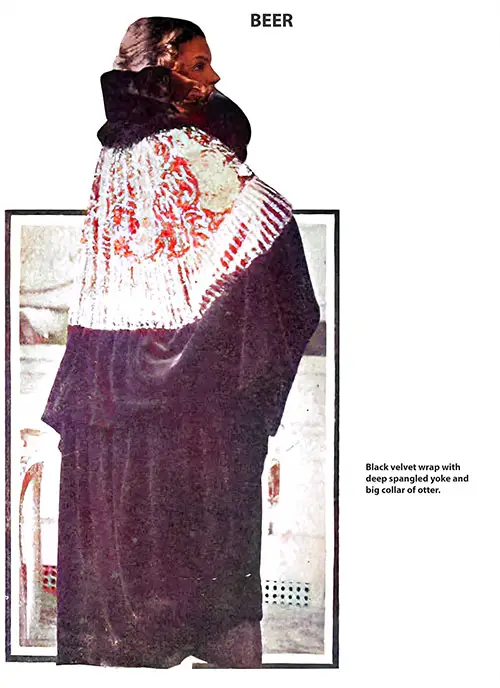
Black Velvet Wrap by Beer With Deep Spangled Yoke and Big Collar of Otter. Garment Manufacturers' Index, October 1922. GGA Image ID # 1a4d14f12b
The coat may be worn over a separate front—a green cloth had a detached back over a satin front, while a blue serge opened over a brick front embroidered with prominent shawl pattern motifs.
One blue serge over black had no trimmings and needed none. It was made of new stuff, serge kashemyrina, the goods woven at intervals with tiny silk braids of a cashmere design. A chic geranium cloth, buttoned in a jet from top to bottom, is box-pleated at the back, quite a refreshing change from plain effects.
All these dresses have tight, long sleeves and uncompromising high collars. Black velvet with a severe, dignified line is enlivened by gold embroidery on the belt, sleeves, and front.
The "Medieval" line, tight and low-waisted, is another black velvet piece with a straight shoulder line. The wide armholes, belt, and neck form a square outlined in gold braid and turquoise.
Late afternoon and dinner dresses are ampler, with round necks and looser sleeves; black satin and lace are not lacking. As in every other good house, black runs through the entire collection.
A black satin, with a much-embroidered front of green silk, has a shirred black net tunic worked in rows of green chenille dots; a gorgeous apron of gold and silver lace bordered by sealskin completes a black velvet dress.
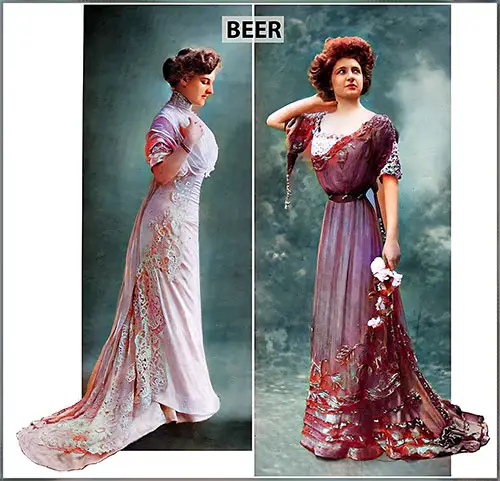
Gowns by Beer. (l) Dinner Gown by Beer. Photo by Reutlinger. (r) Evening Gown by Beer. Photo by Henri Manuel. Les Modes, June 1908, p. 16. | GGA Image ID # 1cb280a232
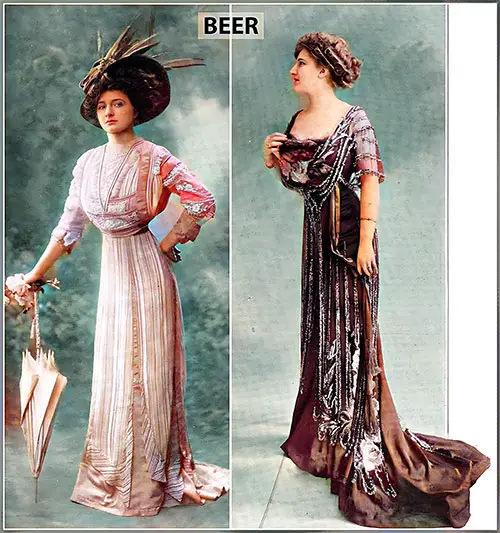
Gowns by Beer. (l) Afternoon Gown by Beer. Photo by Henri Manuel. (r) Evening Gown by Beer. Photo by Reutlinger. Les Modes, June 1908, p. 17. | GGA Image ID # 1cb2512f6c
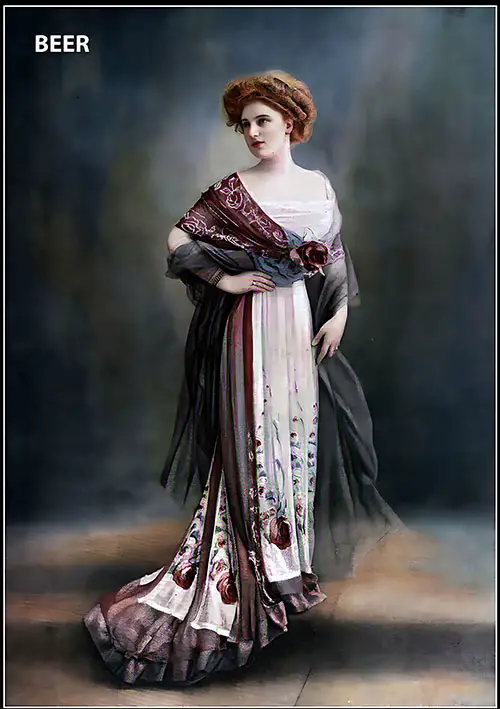
Evening Gown by Beer. Photo by Reutlinger. Les Modes, July 1908, p. 10. | GGA Image ID # 1cb2ebba66
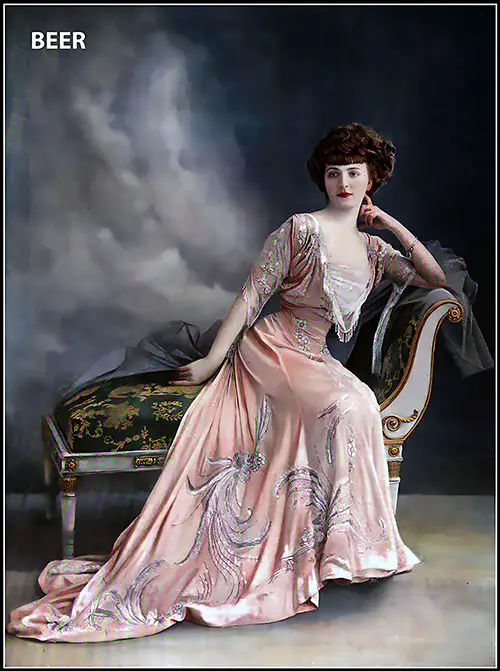
Evening Dress by Beer. Photo by Reutlinger. Les Modes, September 1908, p. 7. | GGA Image ID # 1cb5104dd2
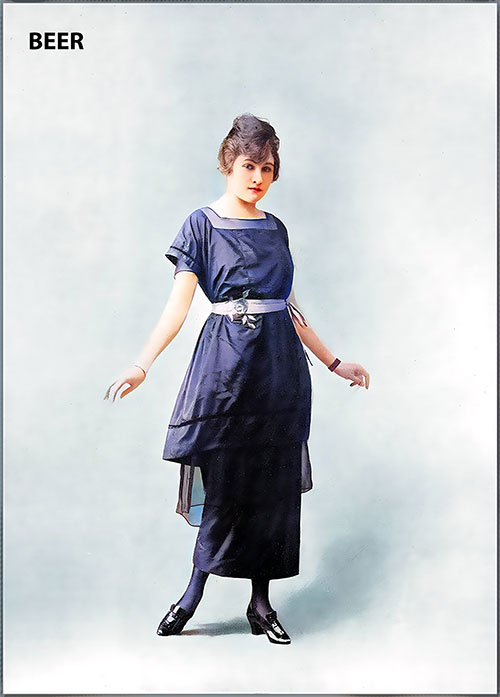
Afternoon Dress by Beer. Photo by Félix. Lex Modes, Issue 181, February 1919, p. 13. | GGA Image ID # 1ce1102d4d
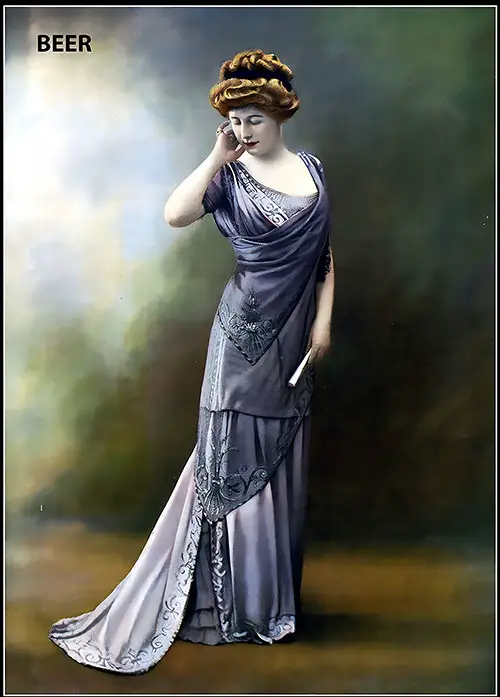
Mlle Louise Bignon Wearing an Evening Gown by Beer. Photo by Félix. Les Modes, Issue 112, April 1910, Front Cover. | GGA Image ID # 1ce15ca6d5
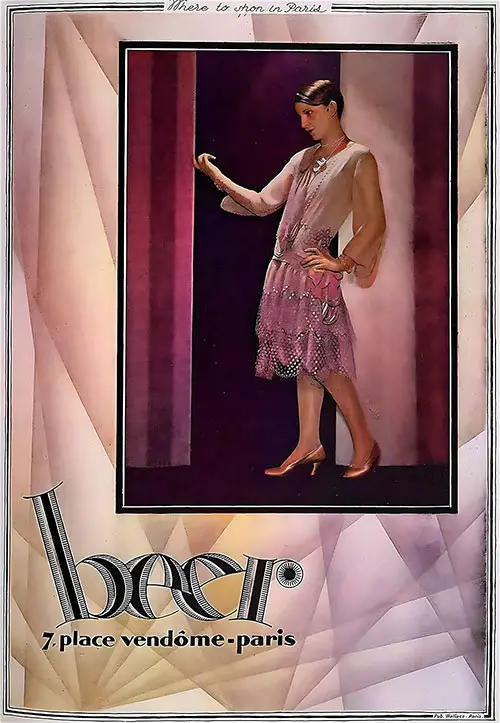
1927 Advertisement for Beer, 7. Place Vendôme - Paris in the Where to Shop in Paris Campaign. (Harper's Bazar, July 1927) | GGA Image ID # 2267694fbb
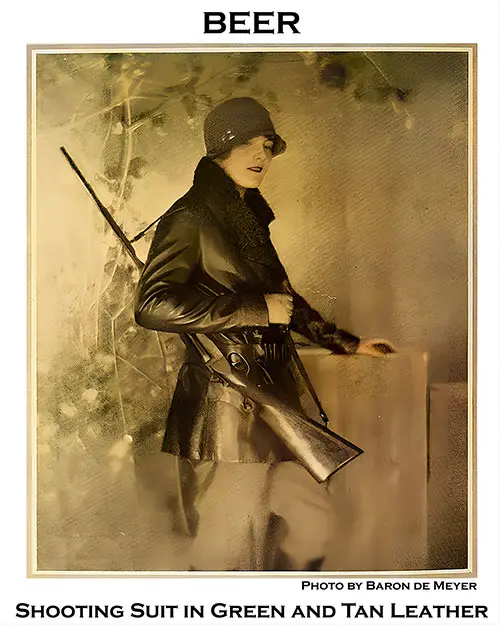
Shooting Suit in Green and Tan Leather by Beer. Photo by Baron de Meyer. (Harper's Bazar, December 1927) | GGA Image ID # 2272bf039c
"Beer" in the Garment Manufacturers' Index, New York: The Allen-Nugent Co. Publishers, Vol. II, No. 3, October 1920: 22.
🚢 Relevance to Ocean Travel and Early 20th-Century Society
In the age of transatlantic crossings, first-class passengers aboard Cunard and White Star liners carefully curated their wardrobes to reflect wealth, refinement, and European taste. Gustav Beer’s creations are ideal for understanding:
🔹 The evolving silhouette from Edwardian elegance to 1920s modernity
🔹 The practical and aesthetic needs of shipboard wardrobes
🔹 The global fashion economy in which Paris dressed New York, Buenos Aires, and Bombay
🔹 The emergence of ready-to-wear luxury alongside haute couture
Beer's garments—ranging from tight day dresses to flowing tea frocks and elaborately embroidered evening gowns—mirror the changing roles of women and the fusion of art, utility, and glamour demanded by international travel.
✨ Key Highlights from the Article
1. 👒 The Afternoon Tea Frock in Mousseline de Soie | Image ID: 1ca8f9629e
Painted by Neysa McMein for Woman's Home Companion (1919)
“Elbows are made to be seen, so the sleeves are only wisps of mousseline... the waist brilliant with coral, gold, and crystal beads.”
This design captures the balance between understated elegance and eye-catching detail, perfect for afternoon promenades at sea or high tea in the salon. The use of black with coral accents is classic Parisian chic, making it highly instructive for fashion and textile students.
2. 🧥 Duvetyn Suit with Cutaway Form | Image ID: 1ca934ac6e
“Graceful lines, rolling fur collar... square-cut back reaching the knees.”
Tailored for traveling women, this green duvetyn suit blends comfort, practicality, and drama. Such garments would have been common for ladies embarking on transatlantic voyages, suited to cold decks and shipboard formality.
3. 🧵 Military Influence in Tailoring | Image ID: 1ca969e811
“A blue cheviot suit, braided with black, long-waisted and belted, with leopard cuffs.”
Reflecting post-WWI influences, this ensemble reveals the militarization of women's fashion and highlights Beer's mastery of tailored, gender-fluid elegance.
4. 👗 Evening and Dinner Dresses with Historic Motifs | Image IDs: 1cb280a232, 1cb5104dd2, 1ce15ca6d5
“Velvet, net, beadwork, and medieval lines—off-the-shoulder bodices, rich embroidery, and architectural silhouettes.”
These gowns are perfect studies in Belle Époque and early Art Deco aesthetics, and would have dazzled in ocean liner dining rooms, theater boxes, or embassy receptions.
5. ❄️ Coats with Dramatic Yokes and Fur Trim | Image IDs: 1a4d14f12b, 1ca9909bf7
“Spangled yokes… squirrel treated to resemble chinchilla… capes thrown like officer’s cloaks.”
These outerwear masterpieces are especially relevant for students exploring textile innovation, theatrical silhouettes, and the symbolism of luxury materials like fur during a period of global transformation.
🧠 Brief Glossary of Terms
Cheviot: Sturdy wool fabric originally from Scotland, used in tailored suits.
Crepe de Chine: Fine, crinkled silk fabric, used for both day and evening wear.
Duvetyn: Soft wool fabric with a suede-like finish, perfect for winter garments.
Medieval Line: Refers to square necks, long tight sleeves, and architectural shaping inspired by medieval dress.
Mousseline de Soie: Lightweight, sheer silk muslin often used in evening gowns.
Shirring: Gathering fabric to create volume or decorative texture.
Velours de Laine: “Wool velvet,” a plush yet structured fabric often used in luxury winterwear.
Yoke: A fitted upper portion of a garment, often decorated.
🖼️ Noteworthy Images (Perfect for Presentations)
📸 Image ID | Description
- 1ca8f9629e | Black and coral mousseline tea gown – femininity and flair
- 1ca934ac6e | Green duvetyn travel suit with cutaway back
- 1ca969e811 | Blue cheviot military suit with leopard cuffs
- 1ca9909bf7 | White chiffon gown with Hercules braid girdle
- 1a4d14f12b | Black velvet wrap with spangled yoke and otter collar
- 1cb280a232 & 1cb5104dd2 | Dinner and evening gowns, full-length portraits
- 1ce15ca6d5 | Cover image of Louise Bignon in a Beer evening gown
🎓 Relevance for Educators, Students, Genealogists & Historians
📘 For Teachers & Students:
🔹 Fashion students can examine Beer's work for lessons in construction, embellishment, silhouette, and the integration of cultural and historical references.
🔹 History students can explore the intersection of gender, class, and material culture, especially in a post-WWI context.
🔹 Encourage students to cite this GG Archives article for essays on modernity, identity, or textile arts.
📸 For Genealogists:
Understanding Beer's styles helps identify and date family photos, particularly for women of means from Europe and North America between 1908–1922.
🎭 For Historians of Fashion & Theater:
Beer's designs often graced actresses and public figures. His blend of showmanship and subtlety is useful for researchers exploring costume design, celebrity fashion, and social performance.
📚 How to Cite This Page
Chicago Style
Footnote:
Gjenvick-Gjønvik Archives, “Gustav Beer: Parisian Elegance and the Tailored Splendor of Early 20th-Century Fashion,” GG Archives, accessed Month Day, Year, https://www.ggarchives.com/OceanTravel/Fashions/FashionHouses/Beer-ParisianEleganceTailoredSplendor.html.
Bibliography:
Gjenvick-Gjønvik Archives. “Gustav Beer: Parisian Elegance and the Tailored Splendor of Early 20th-Century Fashion.” GG Archives. Accessed Month Day, Year. https://www.ggarchives.com/OceanTravel/Fashions/FashionHouses/Beer-ParisianEleganceTailoredSplendor.html.
APA Style
Gjenvick-Gjønvik Archives. (1900s–1920s). Gustav Beer: Parisian Elegance and the Tailored Splendor of Early 20th-Century Fashion. GG Archives. Retrieved Month Day, Year, from https://www.ggarchives.com/OceanTravel/Fashions/FashionHouses/Beer-ParisianEleganceTailoredSplendor.html
MLA Style
Gjenvick-Gjønvik Archives. “Gustav Beer: Parisian Elegance and the Tailored Splendor of Early 20th-Century Fashion.” GG Archives, 1900s–1920s. Web. Accessed Day Month Year. https://www.ggarchives.com/OceanTravel/Fashions/FashionHouses/Beer-ParisianEleganceTailoredSplendor.html
💬 Final Thoughts – Why This Article Matters
Gustav Beer’s fashion legacy, captured in photographs, descriptions, and rare publications, offers a compelling window into the elegance of a bygone world. From elaborately draped evening gowns to crisp military-inspired tailoring, Beer’s creations reflect both the aesthetic trends and the cultural shifts of an era marked by movement—across borders, oceans, and ideas.
📚 Teachers, students, and researchers should embrace this article as a living archive of fashion, society, and transatlantic identity. Every bead, fur collar, or stitched panel tells a story of a world both refined and rapidly changing.
